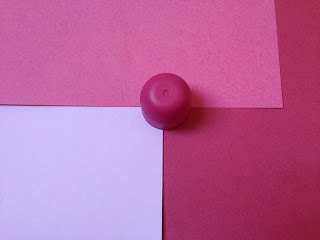In this experiment I looked at the contrast of saturation. I chose the most saturated and the least saturated of the objects and placed them next to each other. Doing this enabled me to see the contrast between each object and the wide span of one colour.
I also carried this out with the second most saturated and least saturated objects. By placing more of the least saturated piece of paper over the most enabled me to see how powerful the most saturated paper was. This could also apply to the contrast of extension as they are both fighting for attention.
By placing an object in the centre of these pages which was closer to the darker colour enabled me to see how different shades can affect the look of an object. The dark pink lid leans more towards the darker colour and looks relatively the same as it would against a neutral background whereas against the lighter shade it looks slightly different.
Moving it away from the darker paper showed me further how colours affect their surroundings. By moving the object away from the darker colour and further onto the lighter colour changed my perception considerably, to me the lid looks slightly darker than it did in the centre of the two pages I think this is down to the darker colour not fighting for attention with the lid.
The paper and the lid are very similar in tone which does not affect the perception by a large amount. With this image I have removed the lighter paper in order to see how the colours would react to each other. I think it is very interesting to see how the lighter colour affected the relationship between these objects. I would say that the objects are in harmony as each stands by itself and is not fighting for attention.
When photographing from a different angle the colours changed significantly, this is down to the amount of natural light within each photo. From this angle the red paper seems considerably lighter and a cooler tone than the darker pink lid.
Placing two highly saturated objects together was very interesting. Each is fighting for attention and in doing so they seem to be merging together. The contrast of extension is very high in this image even with the ratio of each object at completely different ends of the scale.
I wanted to experiment with a matte desaturated colour and a shiny saturated object. I think the shine on the tin enables the object to take on many different shades within the natural light. The tin looks both pure and desaturated against the light colour.
Using the same ideology I placed a matte object on top of a piece of material. The result was as I expected, the lid looks significantly darker in comparison to the material. This is quite an obvious finding as both are at different ends of the saturation scale.
Placing the tin on top of a more saturated piece of paper changed the colours slightly. I feel that by placing the tin with the darker colour made the tin look a lot darker, this is again down to the reflectivity of the shiny material.
When the perfume bottle was placed in the centre of the two pieces of paper it seemed to merge with the more saturated paper, by placing it further away from the darker paper it appears more like it does against a neutral colour.



































Leave your comment